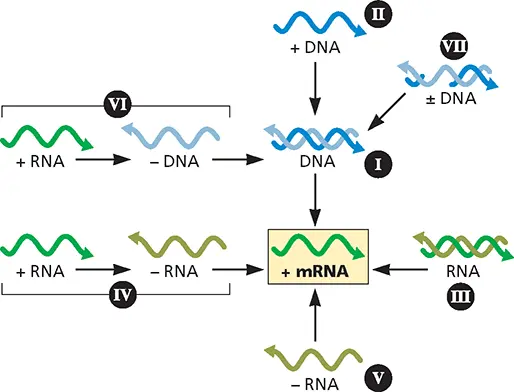Jane Flint - Principles of Virology, Volume 1
Здесь есть возможность читать онлайн «Jane Flint - Principles of Virology, Volume 1» — ознакомительный отрывок электронной книги совершенно бесплатно, а после прочтения отрывка купить полную версию. В некоторых случаях можно слушать аудио, скачать через торрент в формате fb2 и присутствует краткое содержание. Жанр: unrecognised, на английском языке. Описание произведения, (предисловие) а так же отзывы посетителей доступны на портале библиотеки ЛибКат.
- Название:Principles of Virology, Volume 1
- Автор:
- Жанр:
- Год:неизвестен
- ISBN:нет данных
- Рейтинг книги:5 / 5. Голосов: 1
-
Избранное:Добавить в избранное
- Отзывы:
-
Ваша оценка:
- 100
- 1
- 2
- 3
- 4
- 5
Principles of Virology, Volume 1: краткое содержание, описание и аннотация
Предлагаем к чтению аннотацию, описание, краткое содержание или предисловие (зависит от того, что написал сам автор книги «Principles of Virology, Volume 1»). Если вы не нашли необходимую информацию о книге — напишите в комментариях, мы постараемся отыскать её.
Volume I: Molecular Biology
Volume II: Pathogenesis and Control
Principles of Virology, Fifth Edition
Principles of Virology, Volume 1 — читать онлайн ознакомительный отрывок
Ниже представлен текст книги, разбитый по страницам. Система сохранения места последней прочитанной страницы, позволяет с удобством читать онлайн бесплатно книгу «Principles of Virology, Volume 1», без необходимости каждый раз заново искать на чём Вы остановились. Поставьте закладку, и сможете в любой момент перейти на страницу, на которой закончили чтение.
Интервал:
Закладка:

Properties of some of the largest currently known giants, all of which infect amoebae, with representative vertebrate-infecting DNA viruses, of which poxviruses are the largest.The broad range of nucleic acid composition among the amoeba viral genomes is illustrated by the substantial differences in their G+C content. The number of known or putative coding genes in each viral genome is listed. Examples of small, medium, and large mammalian viruses (poliovirus, herpesvirus, and vaccinia virus, respectively) are included for comparison.
For illustrations of giant amoeba virus structures, see http://viralzone.expasy.org/all_by_species/670.html. See also TWiV 261: Giants among viruses. Interview with Drs. Chantal Abergel and Jean-Michel Claverie at http://www.microbe.tv/twiv/twiv-261-giants -among-viruses/.
Abrahão J, Silva L, Silva LS, Khalil JYB, Rodrigues R, Arantes T, Assis F, Boratto P, Andrade M, Kroon EG, Ribeiro B, Bergier I, Seligmann H, Ghigo E, Colson P, Levasseur A, Kroemer G, Raoult D, La Scola B. 2018. Tailed giant Tupanvirus possesses the most complete translational apparatus of the known virosphere. Nat Commun 9:749–761.
Colson P, La Scola B, Levasseur A, Caetano-Anollés G, Raoult D. 2017. Mimivirus: leading the way in the discovery of giant viruses of amoebae. Nat Rev Microbiol 15:243–254.
Colson P, La Scola B, Raoult D. 2017. Giant viruses of amoebae: a journey through innovative research and paradigm changes. Annu Rev Virol 4:61–85.
Racaniello V. 8 March 2018. Only the ribosome is lacking. Virology Blog. http://www.virology.ws/2018/03/08/only-the-ribosome-is-lacking/.
Schulz F, Yutin N, Ivanova NN, Ortega DR, Lee TK, Vierheilig J, Daims H, Horn M, Wagner M, Jensen GJ, Kyrpides NC, Koonin EV, Woyke T. 2017. Giant viruses with an expanded complement of translation system components. Science 356:82–85.

Figure 1.12 The Baltimore classification. The Baltimore classification assigns viruses to seven (I to VII) distinct classes on the basis of the nature and polarity of their genomes. Because all viruses must produce mRNA that can be translated by cellular ribosomes, knowledge of the composition of a viral genome provides insight into the pathways required to produce mRNA, indicated by arrows. See also Baltimore D. 1971. Bacteriol Rev 35:235–241.
By convention, mRNA is defined as a positive [(+)] strandbecause it contains immediately translatable information. In the Baltimore classification, a strand of DNA that is of equivalent sequence is also designated a (+) strand. The RNA and DNA complements of (+) strands are designated negative [(−)] strands.
As originally conceived, the Baltimore scheme included six classes of viral genomes (designated I to VI). When the gapped DNA genome of hepadnaviruses (e.g., hepatitis B virus) was discovered, these viruses were assigned to a seventh class (VII). The DNA and RNA descriptors for the viral classes [single-stranded DNA (ssDNA), double-stranded DNA (dsDNA), (+) RNA, or (–) RNA, etc.], but not the Roman numeral designations, have been adopted universally and are a valuable complement to classical taxonomy. The information embodied in classification by genome type provides virologists with immediate insight into the steps that must take place to initiate the replication and expression of any viral genome.
Because the viral genome carries the entire blueprint for virus propagation, molecular virologists have long considered it the most important characteristic for classification purposes. Although individual virus families are known by their classical designations, they are commonly grouped according to their genome type. In the ICTV compilation, all viral families are assigned to one of the seven classes described in the Baltimore system ( Fig. 1.13).
A Common Strategy for Viral Propagation
The basic thesis of this textbook is that allviral propagation can be described in the context of three fundamental properties.
Viral genomes are packaged inside particles that mediate their transmission from host to host.
The viral genome contains the information for initiating and completing an infectious cycle within a susceptible, permissive cell.
An infectious cycle includes attachment and entry, decoding of genome information, genome replication, and assembly and release of particles containing the genome.
Viral propagation is ensured by establishment in a host population.
Perspectives
The study of viruses has increased our understanding of the importance and ubiquitous existence of these diverse agents and, in many cases, yielded new and unexpected insight into the molecular biology of host cells and organisms. Indeed, because viruses are obligate molecular parasites, every tactical solution encountered in their reproduction and propagation must of necessity tell us something about the host as well as the virus. Some of the important landmarks and achievements in the field of virology are summarized in Fig. 1.14. It is apparent that much has been discovered about the biology of viruses and about host defenses against them. Yet the more we learn, the more we realize that much is still unknown.
In the first edition of this textbook (published in 2000), we noted that the most recent (1995) report of the ICTV listed 71 different virus families, which covered most new isolates. We speculated therefore that: “As few new virus families had been identified in recent years, it seems likely that a significant fraction of all existing virus families are now known.” In the intervening years, this prediction has been shattered, not only by the discovery of new families of viruses, including giant viruses with genome sizes that surpass those of some bacteria, but also by results from metagenomic analyses. For example, the fact that a high percentage (93%) of protein-coding sequences in the genomes of the giant Pandoraviruses have nohomologs in the current databases was totally unexpected. The unusual morphological features and atypical reproduction process of these viruses were also surprising. In addition, it is mind-boggling to contemplate that of almost 900,000 viral sequences identified in samples of only one type of ecosystem (raw sewage), more than 66% bore norelationship to any viral family in the current database. From these analyses, and similar studies of other ecosystems (i.e., oceans and soil), it has been estimated that only a minor percentage of extant viral diversity has been explored to date. Clearly, the viral universe is far more vast and diverse than suspected only a decade ago, and there is much fertile ground for gaining a deeper understanding of the biology of viruses and their host cells and organisms.

Figure 1.13 Viral families sorted according to the nature of the viral genomes. A wide variety of sizes and shapes are illustrated for the families of viruses that infect vertebrates. Families are identified by Latinized names and organized in seven distinct classes, based on the nature of their genomes. Genome replication cycles are illustrated in the column at the left. Similar diversity exists for the families of viruses that infect other life forms, but the chart lists only the approximate number found to date in each class. As noted in the 9th and 10th ICTV Reports, in some cases there are as yet no examples. Data from King AMQ et al. 2012. Virus Taxonomy: The Classification and Nomenclature of Viruses ( https://talk.ictvonline.org/ictv-reports/), with assistance from Dr. Elliot J. Lefkowitz, Department of Microbiology, Director of Informatics, UAB Center for Clinical and Translational Science, Birmingham, AL ( http://www.uab.edu/bioinformatics/).
Читать дальшеИнтервал:
Закладка:
Похожие книги на «Principles of Virology, Volume 1»
Представляем Вашему вниманию похожие книги на «Principles of Virology, Volume 1» списком для выбора. Мы отобрали схожую по названию и смыслу литературу в надежде предоставить читателям больше вариантов отыскать новые, интересные, ещё непрочитанные произведения.
Обсуждение, отзывы о книге «Principles of Virology, Volume 1» и просто собственные мнения читателей. Оставьте ваши комментарии, напишите, что Вы думаете о произведении, его смысле или главных героях. Укажите что конкретно понравилось, а что нет, и почему Вы так считаете.



